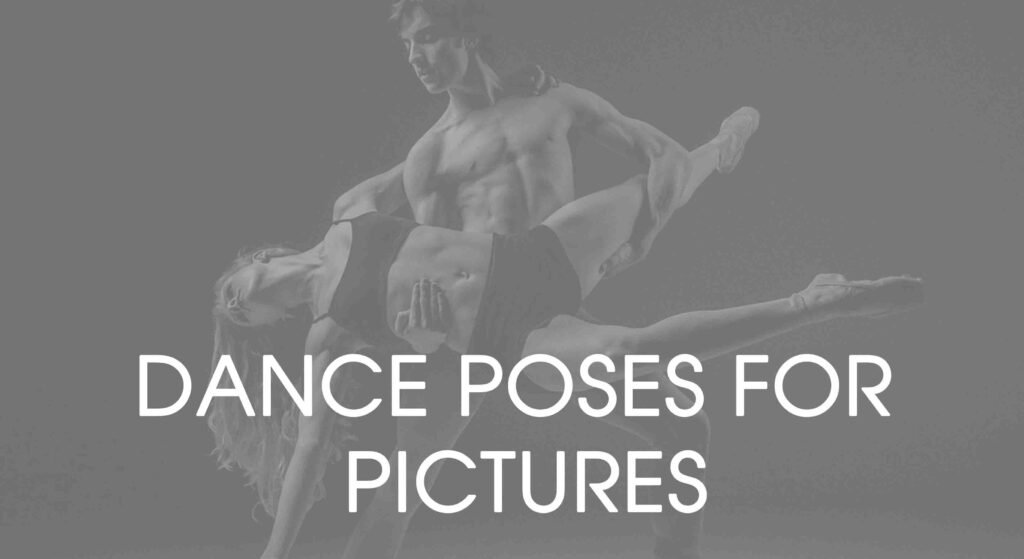Capturing dynamic and expressive dance poses in photographs can be a beautiful and creative endeavor. Whether you’re photographing professional dancers or capturing a friend’s dance performance, here are some classic and striking dance poses that can make for stunning pictures:
- Arabesque:
- A classic ballet pose with one leg extended behind the dancer, often at a 90-degree angle.
- Grand Jeté:
- A dramatic leap in which the dancer extends one leg forward and the other leg straight back.
- Attitude:
- A pose where one leg is raised, bent at a 90-degree angle, and the other leg supports the body’s weight.
- Pirouette:
- A spin on one leg, often performed in a graceful, controlled manner.
- Plie:
- A foundational ballet pose involving a bent-knee stance, either in demi-plié (half-bend) or grand-plié (full bend).
- Lyrical Flow:
- Capturing the fluid and expressive movements of contemporary or lyrical dance styles.
- Leg Extension:
- A pose where the dancer extends one or both legs to create a long, elegant line.
- Leap in Second Position:
- A jump where the dancer leaps into the air with their legs apart, forming a “V” shape.
- Partner Poses:
- Capturing the interaction between dancers in duets or group performances.
- Floor Work:
- Photographing movements and poses when the dancer is on the ground, common in contemporary and modern dance.
- Turns and Spins:
- Capturing the grace and balance of turns like fouetté, chaine, and multiple pirouettes.
- Silhouette Shots:
- Utilizing backlighting to create striking outlines of the dancer’s body.
- Reflections:
- Using reflective surfaces like water or mirrors to add an artistic dimension to the image.
- Jumping Poses:
- Freezing moments of elevation in jumps, showcasing the dancer’s strength and agility.
- Expressive Emotions:
- Capturing the dancer’s facial expressions and emotions, conveying the story or mood of the performance.
Remember, timing and lighting are crucial in dance photography. Ensure you have sufficient light to freeze motion and consider using a fast shutter speed. Additionally, experimenting with different angles and perspectives can yield unique and captivating results. Always communicate and collaborate with the dancer to capture their movements and style effectively.
- What is Midjourney
 Discover the capabilities of Midjourney AI, learn how to effectively utilize the platform, and explore the advantages and disadvantages of the Midjourney AI image generator across its different pricing options.
Discover the capabilities of Midjourney AI, learn how to effectively utilize the platform, and explore the advantages and disadvantages of the Midjourney AI image generator across its different pricing options. - Brand identity elements
 In the vast marketing universe, imagery is pivotal in establishing and nurturing a brand’s identity. A brand’s visual choices are not merely aesthetic decisions but strategic moves that can significantly influence perception and performance. This Picfixs article explores the intricacies of selecting imagery that complements and enhances a brand’s essence, ensuring it resonates with the… Read more: Brand identity elements
In the vast marketing universe, imagery is pivotal in establishing and nurturing a brand’s identity. A brand’s visual choices are not merely aesthetic decisions but strategic moves that can significantly influence perception and performance. This Picfixs article explores the intricacies of selecting imagery that complements and enhances a brand’s essence, ensuring it resonates with the… Read more: Brand identity elements - 100 Best Mountain Captions and Mountain Quotes for Instagram
 Ready to scale new social media heights? Look no further than this treasure trove of 100 exhilarating captions and quotes, handpicked for your Instagram mountain posts!
Ready to scale new social media heights? Look no further than this treasure trove of 100 exhilarating captions and quotes, handpicked for your Instagram mountain posts! - Symmetry in Photography: A Creative Approach with Examples
 Delve into the enchanting realm of symmetry in photography as we showcase mesmerizing examples on our website. Experience the allure of perfectly mirrored images!
Delve into the enchanting realm of symmetry in photography as we showcase mesmerizing examples on our website. Experience the allure of perfectly mirrored images! - 11 Quarantine Photoshoot Ideas to Try at Home for Amazing Photos
 Looking for unique photoshoot ideas during quarantine? Explore the 11 creative suggestions that will help you capture unforgettable moments at home.
Looking for unique photoshoot ideas during quarantine? Explore the 11 creative suggestions that will help you capture unforgettable moments at home.


